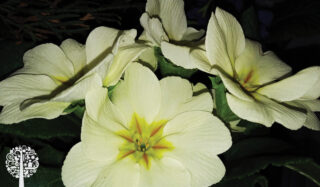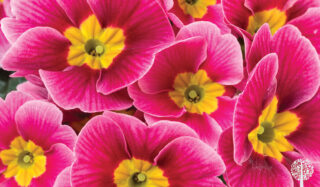Primrose is easy to find at your local garden center around this time of year. They’re an uplifting addition to the garden because when they bloom, it means spring is just around the corner!
Pretty Primrose
This flower’s botanical name, “primula,” literally means ‘the first.’ Many varieties, including the popular primula x polyantha, will bloom before the crocus or snowdrops appear. A tiny plant about eight inches in diameter, even the largest varieties, like the primula denticulate or drumstick primrose, grow to only a foot high. Flowers rise in clusters or on a single stem from a rosette of thick, leathery-looking leaves and appear in bright red to lemon yellow, with every imaginable variegation in between. The purple with a bright yellow center is my favorite!
Typically considered a short-lived perennial, many varieties will return year after year if given the proper care and attention. But be careful; primroses are toxic to pets and humans, so always wear garden gloves when handling the plant.


Planting
Primulas aren’t sun worshippers and are happiest if planted in a lightly shaded spot. Spreading through underground rhizomes, they quickly become root-bound if left in a small pot. After flowering in the late spring, repot the plant in a container twice the diameter of its root. This gives it space to grow, and the extra soil layers around its center keep it insulated during heat and cold periods.
Propagation, Watering, and Pests
Every three to five years, dig up the rootstock and cut it in half, returning both halves to a container or the garden bed.
Primulas like some moisture but don’t like to be too wet. This can cause fungal infections and crown or root rot, so use a well-draining porous soil.
As for pests, slugs and snails are common but can be deterred by crushing up some garlic and scattering it around the base of the plant. Repel spider mites and aphids with soapy water.
Garden Notes
I love seeing the primulas go on sale in January; it tells me the darkness of winter is soon over. I buy three or four just for that reason!
Do they survive year to year? Last winter, temperatures hovered around freezing for most of December and January, even on the mild west coast. Despite being buried under the snow for weeks, the primulas I planted in the ground the year before bloomed in mid-January.


Bring blooming primulas in pots under cover if it’s raining or snowing, and cover those planted in the ground with a bucket. They’re fussy about their flowers; too much precipitation will cause the blooms to be mushy.
The only extra attention I give my primulas is to pinch off the faded flowers and leaves to keep them blooming. Other than that, I water lightly and ignore them. They’re easy to care for and a great start to a new year and growing season.
Join me next month as we garden and grow together!
![]()
